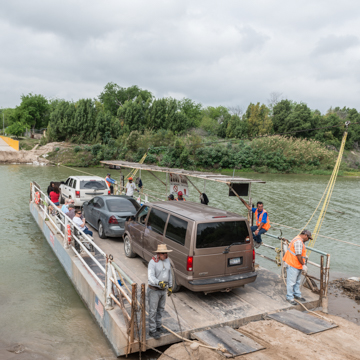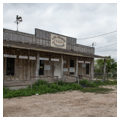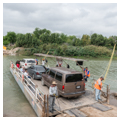South of Rio Grande City, as the topography and vegetation gradually evolve into the river delta, Los Ebanos is home to the last United States–Mexico border crossing served by a ferry, a historic transportation mode used to cross the Rio Grande before the advent of bridges. Located at an ancient crossing point, the ferry is accessed after traversing the diminutively scaled community named by early ranchers for the patch of ebony trees at the riverbanks. Linking the Texas border with the Mexican community of Ciudad Díaz Ordáz, the ferry was licensed in 1950, giving indication of the acceptance by the local population of such traditional crossing modes at that late date. The rectangular, flat metal barge holds three vehicles plus a handful of passengers and crosses the river every five minutes using a system of pulleys and ropes that are pulled by hand by a long-standing crew of Mexican nationals.
You are here
Los Ebanos Ferry
If SAH Archipedia has been useful to you, please consider supporting it.
SAH Archipedia tells the story of the United States through its buildings, landscapes, and cities. This freely available resource empowers the public with authoritative knowledge that deepens their understanding and appreciation of the built environment. But the Society of Architectural Historians, which created SAH Archipedia with University of Virginia Press, needs your support to maintain the high-caliber research, writing, photography, cartography, editing, design, and programming that make SAH Archipedia a trusted online resource available to all who value the history of place, heritage tourism, and learning.





